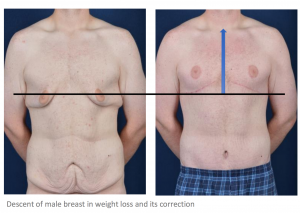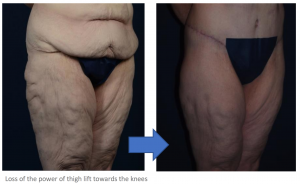
The Reality of Skin Elasticity After Bariatric Surgery
May 15, 2017For nearly two decades my practice has emphasized massive weight loss body contouring. From the early days of this evolving field to our understanding today, as plastic surgeons, we have learned about the triumph of body contouring after weight loss and the transformational effect of these operations. We have also learned about the limitations of such procedures considering the ravages of weight loss.
Skin, the largest organ of our body, shields and holds extra fat during obesity, and with the advent of weight loss, like a deflating balloon becomes redundant and excessive. Along with it becoming abundant, skin loses its characteristics.
This totally intricate part of the body that shields us from dehydration, protects us from the environment, and allows us to adorn it with permanent graphics, becomes lax, tired and uncooperative. Skin laxity and loss of the architectural elements of skin due to massive weight gain and loss is the most important limitation of adequate results that can be achieved from massive weight loss body contouring.
Skin Elasticity: Inflation
Weight gain is a volumetric inflation. Like a balloon that stretches with the inflation of air, skin also undergoes a stretching journey. In many cases, such inflation is sustained. The obese patient, due to a myriad of consequences, allows years of obesity to mold and shape the skin to the overweight state. It is strongly believed that skin, in its inflated state, loses some of the strength of its characteristics. A recent study has shown that skin that sustains a stretch due to massive weight gain is left with defective collagen matrix (the scaffolding of the skin), and degraded elastin (an important building block of skin). It is also believed that obesity-induced hormonal changes such as insulin resistance, causes changes to the microvascular system of the skin and causes microangiopathy (disease of small vessels).
Skin Elasticity: Deflation
And then comes deflation. Such deflationary event, weight loss, takes the cover of the body, that has for years been inflated, damaged and stretched, and turns it into to an abundance of loose unruly tissue. The effects are wide ranging and inflict laxity and looseness to the face, upper body, breast, lower body, and extremities. There is not one region of the body that does not see the catastrophic effects of significant weight loss. Skin becomes damaged and it becomes redundant. Such is the effect of weight loss, and as plastic surgeons we are always vigilant in our quest to produce the best results, only to be faced with the reality of the loss of elasticity of skin due to weight loss and gain.
Compounded on all of this is the variable presentations that weight loss produces with different individuals and body shapes. I always tell my patients that no one gains weight the same, and concurrently no one loses weight the same.
Patients present to us not only with a significant excess of skin but with different and variable types of body shape after weight loss. Some are multifold, some are very thin, some are bottom heavy and some are still fighting weight loss. We see men and we see women. Young and old. However, the theme is constant – there is excess skin and it has lost its quality.
Along with differing body shapes, there is a significant distortion of the entire skin envelope that is circumferential and global. Such distortion disrupts anatomic landmarks and accumulates skin is specific areas, such as the pannus formation above the groin area.
Along with such distortion also comes a loss of anatomic landmarks. In some ways, weight loss causes patients to have a “melting” of the outer envelope due to the loss of elasticity. The descent of male breast in weight loss and its eventual correction clearly demonstrates the concept of descent of the skin envelope.
Such weight loss presentation and its correction show the dramatic descent of the breast after weight loss and its eventual reset and correction. Loss of skin elasticity shows itself variably in different body parts. Breasts, upper back, lower body, and extremities have differing levels of descent and perhaps even different skin qualities and hence will react differently to weight loss and its eventual correction. Breasts tend to become lower on the chest wall and accumulate an excess of skin. The side of the chest and upper body tends to fold over. The circumference of the trunk, lower abdomen and back, not only accumulate skin but tends to create pannus. Thighs become dimpled and droopy.
One of the most pertinent areas of the body that shows significant loss of elasticity is the skin of the thigh. It is one of the most difficult parts of the body to correct. The loss of elasticity is so pervasive in the thighs that the effects of the lift do not carry far. When a thigh lift or a lower body lift is done, the most effective parts of the lift are closest to the incision. As one goes lower towards the knees there is a loss of the lift and loss of results. This picture shows a patient after a lower body lift. The blue arrow demonstrates the loss of the power of the lift because of the abundance of laxity of skin.
In conclusion, the transformational effects of massive weight loss body contouring must be gauged against the dramatic and ever-present fight that we have as plastic surgeons with skin laxity. Skin laxity presents itself in many different places in the body and in many different forms. For all such limitations, these operations continue to be some of the most gratifying ones that I do on a routine basis.

 | ABOUT THE AUTHOR Dr. Sepehr Egrari commenced his medical training in Chicago, Illinois. After graduating with top honors from medical school, he completed a rigorous residency in General Surgery in Los Angeles. Following this he began a coveted Fellowship in Plastic and Reconstructive Surgery at one of country's most respected programs: The University of California at Davis Medical Center in Sacramento, California. He has his own practice at Sepehr Egrari, MD, FACS, PC, Plastic Surgery Center. |









